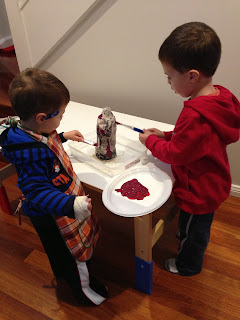I've wanted to do this for a while but have avoided it. So glad we did it though - the kids were so entertained, they played with it for at least 45 minutes - then one thing turned into another and like the other experiments we have done it changed into something completely different!
All you need is:
2 cups of cornflour
1 cup of water
Food colouring
That's it! It's so easy to make - and safe for little fingers (especially if some mixture "accidentally" landed in their mouths haha).
I asked the kids to pour in the cornflour into a bowl. If you do this at home, encourage the kids to run their fingers through the cornflour before you add the water - this is where the sensory learning starts.
Then slowly add the water and ask the kids to quickly mix together the ingredients. While they are mixing, add the food colouring.
It's surprising because it's actually a little hard to mix. I had to get my hands dirty too, to help them along!
After a couple of minutes E became a little bit uneasy, and asked to wash his hands - he didn't like the feel and texture of the mixture. He has always been like this - every time I do an activity where he has to get his hands dirty he avoids it (an example would be when I made jelly but hid some shaped buttons in the jelly for the kids to find - E was the only one who didn't use his hands and asked for a spoon. I did the activity again a few weeks later and he actually quite enjoyed using his hands this time around!).
N kept mixing and lifting the mixture. He thought it was so cool how when he lifted it, the mixture was all stringy. It stuck to his hands and made what looked like a web - he was so excited when he told me about it... "Look mummy! A spider web!! Mummy look!" He was so excited.
E came back from washing his hands and saw the progress N had made with the mixture. He heard him talking about the spider web and immediately became interested again. I guess this is an example of peer tutoring - something I have always been a fan of and think it works really well. A child can learn so much from the actions and reactions of their peers. To my delight it worked a treat! E wanted to make a spider web too, so in went his hands again! Yay!
For added fun I put in some shaped buttons and some cotton reels into the mixture. Pretty soon the kids were stamping the cotton reels into the gloop and making quick prints. They were hiding the shapes in the gloop and started playing "see who can find the most shapes!" I love when kids direct their own learning.
One of the most amazing parts of this mixture is that the gloop is both a solid and a liquid. When you pick it up and squeeze it into a ball, it becomes hard and turns into a solid...
Then you open your fingers and it pretty quickly changes back into a liquid
"Solid or Liquid: Cornflour is made of lots of long, stringy particles. When water is added they do not dissolve in water, but they do spread themselves out. This allows the gloop to act both like a solid and a liquid. When you roll the mixture in your hands or apply pressure to it, the particles join together and the mixture feels solid. But if it is left to rest or is held up and allowed to dribble, the particles slide over each other and it feels like a liquid." (learning4kids.net)
Where did the experiment take us?
You wouldn't believe it if I told you....
Remember how E didn't like the texture at the beginning? After a while he added more water to the mixture... probably about 4 or 5 cups...
Why did he do this?
"Now we can wash our hands, mummy!" He was just so proud of himself! I love how kids minds work :)
It was easy to fix that after they had finished playing - the cornflour sank to the bottom and I was able to pour the excess water out of the container and save the rest by putting it in a snap lock bag.
Believe me when I say it's easier than cleaning up dinner mess!! All you need is a wipe (or 2) and wipe it off... Too easy!














































